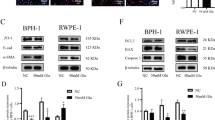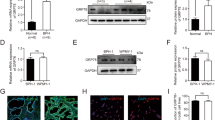Abstract
Purpose
The aim of this study was to compare glucose transporter-4 (GLUT-4) and neuronal nitric oxide synthase (nNOS) expression in diabetic and non-diabetic patients who underwent TUR-P or transvesical prostatectomy with the diagnosis of BPH.
Methods
Thirty diabetic patients with an average age of 58 and 30 non-diabetic patients with that of 56 were included in the study. T-PSA, IPSS, Q max value and prostate volume were compared between the two groups. The stromal and glandular staining scores of GLUT-4 and nNOS expression were compared. Student’s t test and Mann–Whitney U test were used for statistical analysis.
Results
There was no statistically significant difference in terms of age, IPSS, Qmax and PSA. Patients with diabetes had larger prostate volumes (p = 0.02). Mean GLUT-4 glandular total scores in diabetic and non-diabetic patients were 3.36 ± 1.21 and 2.1 ± 1.39, respectively, whereas stromal total scores were 3.63 ± 1.12 and 2.46 ± 1.33, and they were both statistically significant (p = 0.028 and p = 0.032, respectively). Glandular total nNOS scores in diabetic and non-diabetic patients were 4.53 ± 1.0 and 2.80 ± 1.12, while stromal total scores were 1.76 ± 1,0 and 2.30 ± 1.08 and they were found to be statistically significant (p = 0.0001 and p = 0.037, respectively).
Conclusions
GLUT-4 expression was found higher in prostatic tissue of the patients with diabetes mellitus. The expression value of nNOS was higher in the glandular area in diabetic patients, while stromal area expression score was higher in non-diabetic patients. Although our findings indicate important results, carefully designed further studies are needed to better comprehend the role of GLUT-4 and NOS pathways in BPH/LUTS pathophysiology.


Similar content being viewed by others
References
Berry SJ, Coffey DS, Walsh PC, Ewing LL (1984) The development of human benign prostatic hyperplasia with age. J Urol 132:474–479
Lee C, Kozlowski JM, Grayhack JT (1995) Etiology of benign prostatic hyper-plasia. Urol Clin North Am 22:237–246
Donnell RF (2011) Benign prostate hyperplasia: a review of the year’s progress from bench to clinic. Curr Opin Urol 21:22–26
Partin AW, Oesterling JE, Epstein JI et al (1991) Influence of age and endocrine factors on the volume of benign prostatic hyperplasia. J Urol 145:405–409
Hammarsten J, Hogstedt B, Holthuis N, Mellstrom D (1998) Components of the metabolic syndrome—risk factors for the development of benign prostatic hyperplasia. Prostate Cancer Prostatic Dis 1:157–162
Michel MC, Mehlburger L, Schumacher H, Bressel HU, Goepel M (2000) Effect of diabetes on lower urinary tract symptoms in patients with benign prostatic hyperplasia. J Urol 163:1725–1729
Boon TA, Van Venrooij GE, Eckhardt MD (2001) Effect of diabetes mellitus on lower urinary tract symptoms and dysfunction inpatients with benign prostatic hyperplasia. Curr Urol Rep 2:297–301
Mongiu AK, McVary KT (2009) Lower urinary tract symptoms, benign prostatic hyperplasia and obesity. Curr Urol Rep 10:247–253
Hammarsten J, Damber JE, Karlsson M et al (2009) Insulin and free estradiol are independent risk factors for benign prostatic hyperplasia. Prostate Cancer Prostatic Dis 12:160–165
Nandeesha H, Koner BC, Dorairajan LN, Sen SK (2006) Hyperinsulinemia and dyslipidemia in non-diabetic benign prostatic hyperplasia. Clin Chim Acta 370:89–93
Im SS, Kwon SK, Kim TH, Kim HI, Ahn YH (2007) Regulation of glucose transporter type 4 isoform gene expression in muscle and adipocytes. IUBMB Life 59:134–145
Dokita S, Smith SD, Nishimoto T, Wheeler MA, Weiss RM (1994) Involvement of nitric oxide and cyclic GMP in rabbit urethral relaxation. Eur J Pharmacol 15:269–275
Weiner CP, Lizasoain I, Baylis SA, Knowles RG, Charles IG, Moncada S (1994) Induction of calcium-dependent nitric oxide synthases by sex hormones. Proc Natl Acad Sci USA 91:5212–5216
Armour KE, Ralston SH (1998) Estrogen upregulates endothelial constitutive nitric oxide synthase expression in human osteoblast-like cells. Endocrinology 139:799–802
Chamness SL, Ricker DD, Crone JK et al (1995) The effect of androgen on nitric oxide synthase in the male reproductive tract of the rat. Fertil Steril 63:1101–1107
Burnett AL, Maguire MP, Chamness SL et al (1995) Characterization and localization of nitric oxide synthase in the human prostate. Urology 45:435–439
Hedlund P, Ekstrom P, Larsson B, Alm P, Andersson KE (1997) Heme oxygenase and NO-synthase in the human prostate—relation to adrenergic, cholinergic and peptide-containing nerves. J Auton Nerv Syst 63:115–126
Calignano A, Whittle BJ, Di Rosa M, Moncada S (1992) Involvement of endogenous nitric oxide in the regulation rat intestinal mobility in vivo. Eur J Pharmacol 229:273–276
Bryant NJ, Govers R, James DE (2002) Regulated transport of the glucose transporter GLUT-4. Nat Rev Mol Cell Biol 3:267–277
Vikram A, Jena GB, Ramarao P (2010) Increased cell proliferation and contractility of prostate in insulin resistant rats: linking hyperinsulinemia with benign prostate hyperplasia. Prostate 70:79–89
Hammarsten J, Högstedt B (2001) Hyperinsulinaemia as a risk factor for developing benign prostatic hyperplasia. Eur Urol 39:151–158
Kaplan SA, Te AE, Blaivas JG (1995) Urodynamic findings in patients with diabetic cystopathy. J Urol 153:342–344
Brown JS, Wessells H, Chancellor MB et al (2005) Urologic complications of diabetes. Diab Care 28:177–185
Landsberg L (1986) Diet, obesity and hypertension: an hypothesis involving insulin, the sympathetic nervous system, and adaptive thermogenesis. Q J Med 61:1081–1090
Kampmann U, Christensen B, Nielsen TS, Pedersen SB, Ørskov L, Lund S, Møller N, Jessen N (2011) GLUT4 and UBC9 protein expression is reduced in muscle from type 2 diabetic patients with severe insulin resistance. PLoS One 6:e27854
Kouidhi S, Berrhouma R, Rouissi K, Jarboui S, Clerget-Froidevaux MS, Seugnet I, Bchir F, Demeneix B, Guissouma H, Elgaaied AB (2013) Human subcutaneous adipose tissue Glut 4 mRNA expression in obesity and type 2 diabetes. Acta Diabetol 50:227–232
Conflict of interest
None.
Author information
Authors and Affiliations
Corresponding author
Rights and permissions
About this article
Cite this article
Otunctemur, A., Besiroglu, H., Dursun, M. et al. The comparison of GLUT-4 and nNOS expression in diabetic and non-diabetic patients with BPH/LUTS. Int Urol Nephrol 47, 899–904 (2015). https://doi.org/10.1007/s11255-015-0964-6
Received:
Accepted:
Published:
Issue Date:
DOI: https://doi.org/10.1007/s11255-015-0964-6




